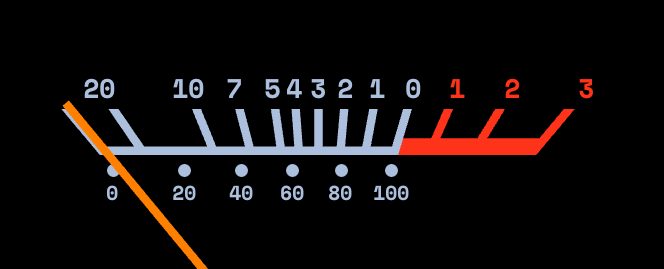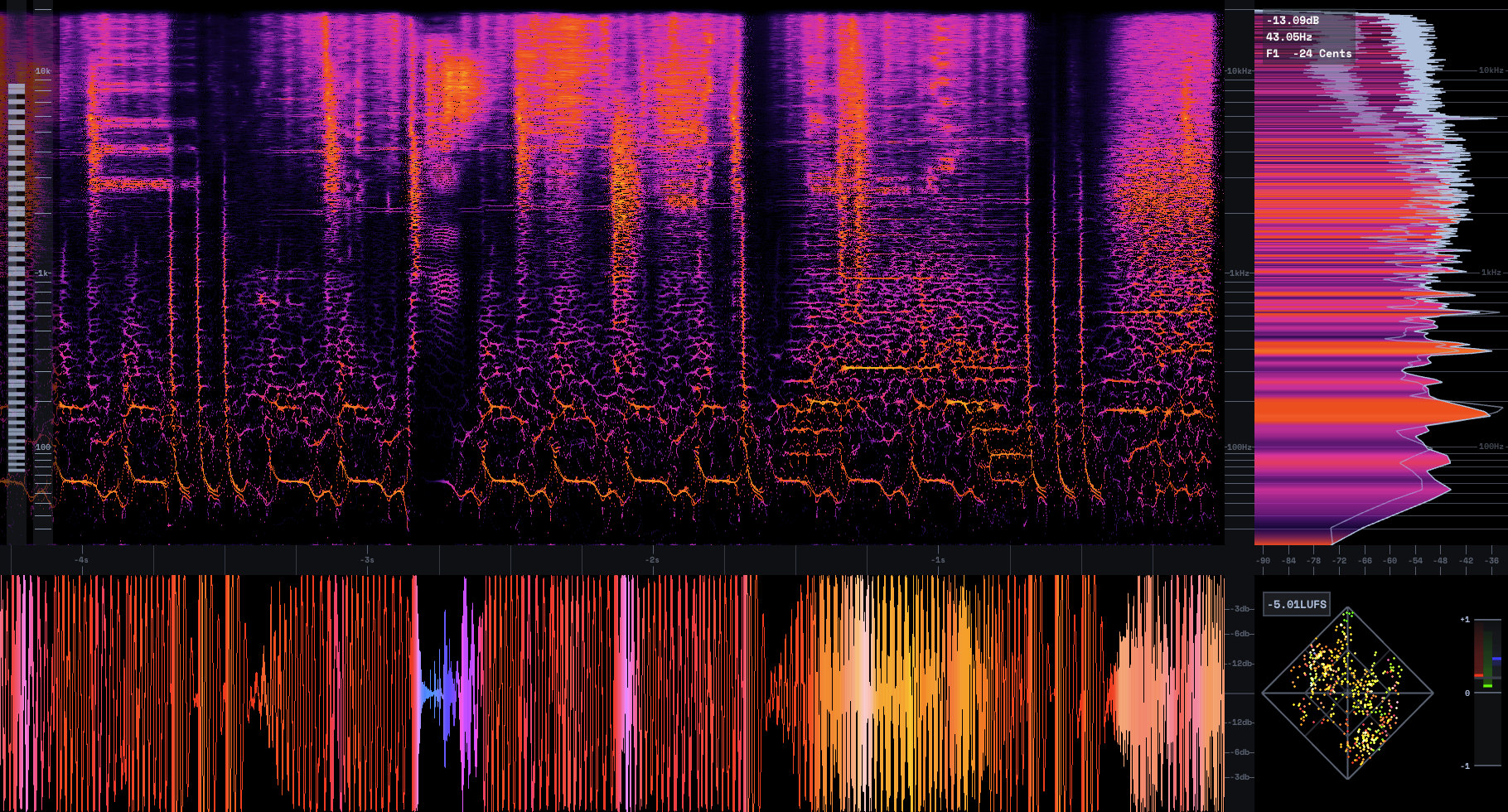MiniMeters v1.0 - A New MiniMeters
Released: Aug 1, 2025
MiniMeters v1.0 is a free update for all current users. For help getting this update please go here: minimeters.app/help/find-updates
Highlights:
- New Meter: VU.
- New layout: Quad.
- Clipping: Save the last 10 or 60 seconds of audio.
- Recording: Record audio from the selected audio source.
- Plug-Ins: Added VST3, Audio Unit, and CLAP plug-ins for every meter + the new Quad Layout.
- Presets: For saving and loading layouts and settings.
- Color Maps: Available to use in the Spectrum, Spectrogram, and Waveform meters.
New! - VU Meter

VU has the following settings:
- Calibration: Calibrate the input volume to match your target.
- Channel Selector: Select between Left, Right, Mid (Mono), and Side.
- Peak: Display a yellow dot when the VU Meter's level reaches the selected value in dBFS.
- Clip: Display a red dot when the VU Meter's level reaches the selected value in dBFS.
New! - Plug-Ins of Every Module
- MiniMeters (Quad Layout) Plug-In
- Oscilloscope Plug-In
- Spectrogram Plug-In
- Spectrum Plug-In
- Loudness Plug-In
- Stereometer Plug-In
- VU Plug-In
- Waveform Plug-In
New! - Quad Layout

MiniMeters now has two available layouts:
- Horizontal - Fully Customizable, Standalone only - As seen in all prior versions of MiniMeters. Best when used on the top or bottom of your screen. Now including "Stick" mode: Automatically arrange windows below or above MiniMeters. Only available on Windows and Linux (when using a compatible Wayland compositor).
- New! Quad - Limited Customizability - A simple Layout with the Spectrogram, Waveform, Spectrum, Stereometer, and a mini Loudness overlay laid out in a grid. Perfect for filling a second monitor, or for use within the new MiniMeters Plug-In.
New! - Presets
- MiniMeters can now save presets! Presets store the position and size of the windows and settings of the selected modules.
- By Default, MiniMeters saves to a temporary preset that is automatically loaded next launch. You will be asked to save upon quitting.
New! - Audio Recording & Clipping
- MiniMeters can now record audio directly from your system or DAW.
- Capture the previous 10 or 60 seconds of audio that MiniMeters received.
- Add the "Clip 10 Seconds" or "Clip 60 Seconds" drag regions in the Toolbar to capture audio and drag it directly into your DAW, Audio Editor, Discord, a File Browser, or anywhere that will accept a WAV file.
- See your most recent recordings by right-clicking on the Record button in MiniMeters's toolbar.
- Recordings are stored in 32-Bit Floating Point WAV files.
New! - Color Maps
- A Color Map can be selected which contains a gradient mapped to volume which targets the display in the Spectrogram, Spectrum, and (optinally) Waveform modules.
- You can create your own Color Maps using the built-in Color Map Editor.
Notable Changes to the Meters:
Waveform:
- Now shows a Time Code overlay when used in the plug-in or when using the Audio Server VST3/AU/CLAP Plug-In with Standalone MiniMeters.
- Added a new Color Mode: Color Map. Color Map maps the colors from the selected Color Map to the volume of each Waveform block.
- Added a Loop option to disable scrolling.
- Removed the ability to use the scroll wheel to change the Speed setting.
- Speed gains a Link button to link the speed to the Spectrogram module. This is particularly useful in the new Quad Layout.
Loudness:
- Added the following modes: "LUFS: Momentary", "LUFS: Short Term", "RMS: Fast", and "RMS: Slow".
- Added a small background behind the meters.
- Added 6dB of padding at the top of the meter.
- Added reference lines at common volumes.
Stereometer:
- Added a Correlation Meter with Single and Multi-Band modes.
- Added a Point Size option to select the size of the dots drawn for each sample.
- Unified the Polarity and Mode selectors into one Style selector.
- When Normalize and Guides are enabled, Guides will now adjust to match the normalized volume level.
Spectrum:
- Added Target Curve overlay.
- Drag an audio file over the Spectrum module to load it as a guide.
- Select the File, Offset, and Spread from the "Overlay" tab in the Spectrum Settings.
- When using the Audio Server plug-in or the Spectrum plug-in holding Ctrl while clicking on the Spectrum will filter the audio allowing for quickly monitoring a particular frequency range.
- FFT Size can now be adjusted from 1024 to 16384.
- Can now be rotated to match the orientation of other meters.
- Added the option to use the "Mel" scale mode.
- Low and High become Range and Center allowing easier adjusting of how much dynamic range you would like to see.
- Frequency Readout has been renamed to dB/Hz/Note Overlay.
- Now has native AVX2, SSE2, and Neon (Arm) optimizations.
Oscilloscope:
- Now uses a linear-phase detector filter to follow zero-crossings more accurately in Pitch mode.
Spectrogram:
- Rewrote the Spectrogram module to be sharper, use less CPU, and be more customizable.
- Added a new Mode: "Sharper" which now improves the clarity in the time domain.
- Multiple FFT Size options added: 1024, 2048, 4096, 8192;
- Added a Piano Overlay.
- Added a Frequency Lines overlay.
- Added a new scale option: Mel, which deprioritizes lower frequencies when compared with Log.
- Added a new setting: Speed. This matches the speed of the Waveform module.
- Added a new setting: Loop.
- Changing the Color Map updates the whole view in realtime. Perfect for customizing your Color Map.
- Now has native AVX2, SSE2, and Neon (Arm) optimizations.
Settings Changes:
- New settings file format called ".mms". This allows for easier editing of the settings and presets files if needed.
- In the Horizontal Layout, the Audio Source section has been redesigned to be clearer.
Improvements:
MiniMeters is now backed by a brand new rendering engine.
- MiniMeters v1.0 now uses Metal on macOS, DirectX 11 on Windows, and OpenGLES 3.0 or OpenGL Core 3.2 on Linux.
Audio Engine:
- MiniMeters is now sample rate independent. All modules will work at the sample rate chosen in your DAW or Audio Interface.
- MiniMeters now uses a simplified audio path which should improve latency.
General:
- MiniMeters now ships CJK fonts for better compatibility with more languages.
- Audio Devices, Themes, Presets, etc can now contain non-ASCII letters without issue.
- Added the ability to always reload the selected preset at launch.
- Added the ability to never show the Save Confirmation dialog.
- You can now hide the Reposition Hint in the Toolbar.
- Added minimize button to the Toolbar.
- Added a Drag Region to the Toolbar so those who cannot hold Alt on Windows, Cmd on macOS, or Super on Linux can still move the window around.
- Added a Hamburger Button at the end of the Toolbar. This includes commonly used options as well as any Toolbar items that may be cut off due to the size of the window.
- Improved layout behavior when enabling and disabling modules. This should result in less shifting of modules when enabled and disabled.
- MiniMeters's platform layer used to interact with the OS has been rewritten from the ground-up to allow for new features such as Drag and Drop and support new features more quickly.
- MiniMeters now uses ".ini" files for Themes with blocks defining colors for each module.
- Visuals no longer freeze while resizing the window.
- Fixed issue where dragging from a module over a resize handle would cause the meter to resize.
macOS:
- You can now use Syphon to capture MiniMeters in OBS or your favorite VJ software. More Info: https://syphon.github.io
- MiniMeters now has traditional app menus in addition to its in-app toolbar.
- MiniMeters now has an icon in the Menu Bar with commonly accessed settings.
- MiniMeters can now appear on top of full-screen applications in certain configurations.
- It is now possible to select audio outputs, other than the default, for monitoring when using MiniMeters on macOS 14.2 and later.
- "Desktop Audio" remains available in macOS 13 - 14.1 with some stability improvements, but due to its buggy nature I cannot provide support if issues arise. I would recommend using macOS 14.2 or newer.
- MiniMeters now restores window positions correctly when display layout or resolution changes.
Windows:
- MiniMeters now uses an NSIS installer packages.
- The installer now remembers previously selected options.
- MiniMeters now restores window positions correctly when display layout or resolution changes.
- MiniMeters no longer opens windows offscreen if a display is disconnected.
- MiniMeters now scales its visuals correctly on high-dpi monitors.
- Horizontal Layout: Added "Stick" mode. Stick mode makes MiniMeters behave like a Toolbar. It will automatically rearrange windows to be below or above MiniMeters depending on your selected settings.
Linux:
- MiniMeters will now read
$XDG_CONFIG_HOMEfor configurations and$XDG_DATA_HOMEfor audio clips and recordings. If those are not set MiniMeters will check for$HOMEand store settings in$HOME/.MiniMeters; audio clips and recordings will be placed in$HOME/.MiniMeters/Recordings. - MiniMeters now supports Wayland.
- MiniMeters supports fractional scaling on Wayland.
- Wayland: MiniMeters defaults to using wlr-layer-shell when using the Horizontal Layout. This causes MiniMeters to behave like a toolbar on the desktop.
- MiniMeters now supports OpenGLES 3.0 in addition OpenGL Core 3.3 on Linux.
- MiniMeters now defaults to OpenGLES on Linux.
- MiniMeters now supports Arm-based systems. This includes the Raspberry Pi, however performance is not guaranteed. Please read the Raspberry Pi Help Page for more info.
Themes / Color Maps:
- Default (Blur Friendly) created by Untwinxer.
- Adds Untwinxer's theme and Color Map.
- Viridis, Magma, Inferno, and Plasma by Bob Rudis, Noam Ross and Simon Garnier
- Cubehelix Color Map by D.A. Green
- Rocket, Flare, Crest, Mako from the Seaborn Python library.
- Fruity: Inspired by the Color Map used by FL Studio's Wave Candy.
Nerdy Stuff:
- The Debug Window includes a simple profiler to help narrow down what parts of the program are causing hiccups and slow downs.
- The Debug Window now includes more information about the currenly running system.
- Holding
Shifton Windows orOptionon macOS while launching MiniMeters will open a "Launch Settings" window with additional options.
Other Changes:
Terminology Changes:
- "Audio Device" has been renamed to "Audio Source" throughout.
- The "Peak/LUFS" meter has been renamed to "Loudness".
- "MiniMetersServer" has been renamed to "Audio Server".
- In the Waveform meter, "None" has been renamed to "Off" in Channel 2 selector.
Settings:
- Sliders have been redesigned to be more space efficient.
- Trim slider now behaves in a more traditional way, hiding the cursor while dragging.
- When modules are too small to display the slider it reverts to a style that is extremely space efficient.
- Moved the Settings button from the lower right of the Horizontal Layout to the Toolbar.
Broken Promises:
Unfortunately, I was not able to implement some ideas prior to my deadline. Including but not limited to the following:
- Vertical Layout.
- HTTP API for use in Stream Deck or similar tools.
- Lua Scripting
- Custom shader support.
Notes: To download this update head here - Log In and click "Download" under "You own this tool." Or go back to your email where you first got the download link.